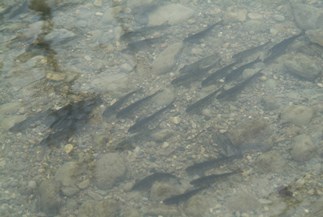Thermal Mitigation
 During warm weather, urban surfaces like pavements and rooftops heat up quickly as they effectively absorb and store heat from the sun. As a result, stormwater shed from these surfaces during rain events is significantly warmer than stormwater runoff from more natural, vegetated landscapes. Stormwater management ponds used to treat urban runoff are also widely understood to have a warming effect on the water passing through them.
During warm weather, urban surfaces like pavements and rooftops heat up quickly as they effectively absorb and store heat from the sun. As a result, stormwater shed from these surfaces during rain events is significantly warmer than stormwater runoff from more natural, vegetated landscapes. Stormwater management ponds used to treat urban runoff are also widely understood to have a warming effect on the water passing through them.
The cumulative impacts of urban runoff, stormwater ponds and reduced stream baseflows associated with urbanization, result in significant warming of the stormwater discharged from urban areas. These elevated temperatures impair receiving water habitat and alter the structure and diversity of downstream aquatic communities. While cold water species like brook trout would be particularly vulnerable to this warming, its impacts extend beyond a particular thermal guild. It can result in ecological alterations that affect the aquatic community and ecosystem in a variety of ways.
Efforts to mitigate the negative impacts of elevated stream temperatures on aquatic organisms have given rise to several strategies and engineered technologies meant to cool the water that is discharged from stormwater management facilities, including:
- Bottom draw outlets in stormwater management ponds
- Cooling trenches installed in stormwater management ponds
- Subsurface trench outlets
- Automated controls on pond outlets to allow stormwater to be discharged at night when it’s cooler
- Shading of the pond’s permanent pool, outfall channel, and paved surfaces in the catchment area
- Improved stormwater pond design (e.g. selecting location and orientation to minimize sun exposure, increasing length-to-width ratio, and application of planted berms within ponds)
- Application of stormwater management facilities without a permanent pool (e.g. infiltration facilities, dry extended detention ponds)
Home page slider image credit:
“Trout” by andrusdevelopment is licensed under CC BY 2.0



